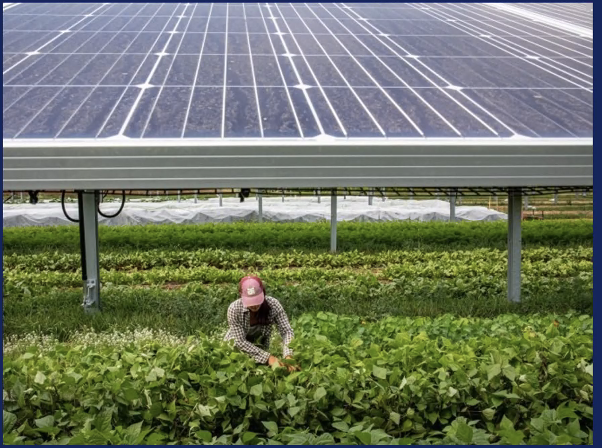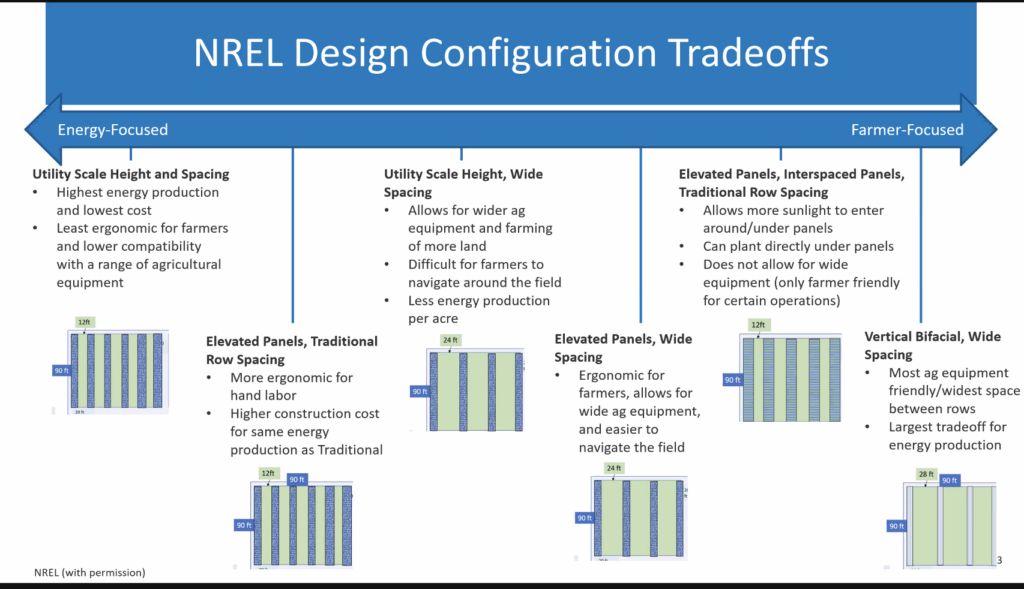Agrivolatics: Solar Energy And The Future Of Farming In Massachusetts

Agrivoltaics: Food crops under raised solar panels. Photo: American Farmland Trust
Report On A Webinar, June 9, 2023
Agrivoltaics, the simultaneous use of land for agriculture and solar photovoltaic energy generation, was the focus of a webinar sponsored by Amherst’s Solar Bylaw Working Group (SBWG) and held over Zoom on June 9. The presenters were Ethan Winter, National Smart Solar Director, American Farmland Trust; Jake Marley, Manager, Hyperion Systems, LLC, Amherst, an agrivoltaics developer; and Gerry Palano, an Alternative Energy Specialist, Massachusetts Department of Agriculture.
The presentation provided a detailed introduction to agrivoltaics, sometimes referred to as agrisolar, dual use solar, or low impact solar. With dual use, photovoltaic panels are installed on farmland in such a manner that primary agricultural activities such as animal grazing or crop production are maintained. Crops may be grown under the panels or livestock may graze under and around solar panels. This system looks at agriculture and solar energy production as complementary to each other instead of as competitors. By allowing working farmlands to stay working, agrivoltaic systems are one way to help farms diversify income. Other potential benefits include increasing energy resilience, a reduced carbon footprint, and in some cases, improved water conservation. UMass Amherst is a pioneer in the development of agrivoltaic systems.
The presenters provided examples of ongoing dual use projects in Grafton, Deerfield, and Hadley and reviewed the pros and cons. Tradeoffs include that dual use typically produces less energy and less agricultural output than a single use site would produce but allows the simultaneous production of energy and food, offering some buffering against instabilities in climate and economy. With Massachusetts leading the nation in conversion of agricultural land to solar fields, and with only 14% of the state’s land currently devoted to crop production, dual use is something that might allow the state to fend off the disappearance of local food production. The presenters emphasized that dual use sites don’t look like what one typically expects a farm to look like and that adopters need to come to terms with the tradeoffs, including that certain crops now grown in Massachusetts are not optimal candidates for dual use. To date, much of dual use has focused on grazing rather than crops. Ideal food crops are those that are somewhat shade tolerant and don’t require a lot of access for large mechanized equipment. The featured project in Deerfield included growing broccoli, chard, kale, and peppers. The cost of generating solar energy is more expensive with agrivoltaics, which require panels to be raised higher off the ground, than with conventional solar arrays (typically 7 to 10 feet) with the cost increasing with the height of the array.

A summary of the presentation follows. A video recording of the presentation will soon be posted on the Solar Bylaw Working Group’s website.
Prevailing Conditions Governing The Development Of Agrivolatics
Ethan Winter, American Farmland Trust (AFT)’s National Smart Solar Director, said that AFT has taken an active role in the development of agrivoltaics and sees them as one fruitful pathway for farmland conservation. He reported that attractive new technologies and markets are evolving rapidly but complex questions remain about how solar and agriculture interact. He suggested Amherst has an opportunity to lead in this area.
The conditions:
The Northeast is starting to experience substantial climate change impacts that are especially significant for farming. Winter noted that we just went through the warmest winter on record and farms are increasingly at risk. Farmers are also seeing an acceleration of conversion of farmland into economically more lucrative and more reliable endeavors (e.g. housing or energy production) as a way to reduce financial risk and increase revenue. He said that we are now at the very beginning of a large-scale energy transition and within that we are seeing an accelerating deployment of utility scale solar.
AFT aims to protect farmland by promoting “climate-smart” agricultural practices and “smart solar siting”. Smart solar siting attempts to simultaneously maximize four principles:
- Prioritize siting solar on buildings and land not well suited for agriculture
- Safeguard the ability for land to be used for agriculture
- Grow agrivoltaics for the production of food crops and energy
- Promote equity and farm viability

There is currently a bipartisan bill under consideration in the U.S. Senate that would allocate $75 million for the development of agrivoltaics. Winter said that the development of local bylaws governing dual use and incorporating smart solar options are an important part of growing agrivoltaics and he commended Amherst for their ongoing work in developing a solar siting bylaw.
Solar developer Jake Marley described a 2.5-acre project at Joe Czajkaowski’s farm in NorthHadley that uses sun-tracking panels, which are more efficient than the fixed tilt system that was employed on earlier projects such as the those featured in Grafton and Deerfield. . He noted that the cost of producing energy with agrivoltaics is increasingly competitive.

Q&A From The SBWG
Dwayne Breger wanted to know whether there is any evidence that agrivoltaics have been helpful in maintaining agricultural viability. Winter replied that in Europe (especially in Italy and Germany) and Asia, agrivoltaics have been built into national economic policy to good effect, and they have also been successful in adding to water conservation efforts in the American west.
Dan Corkran asked if there are permanent impacts to soil health following decommissioning of agrivoltaic arrays. Winter said that a key element considered in the design of arrays is soil compaction and that developers need to avoid using equipment that will require mitigation later. He believes that whatever the challenges, they are manageable. But he added that because most agrivoltaic arrays have been built in the last five years “so we don’t have a lot of experience with decommissioning”.
Jack Jemsek noted that the town’s study of solar array impacts didn’t find much impact on water budgets or quality. He wanted to know whether Winter had seen any projects that degrade water resources.
Winter replied that in the West, where they use a lot of water to clean panels, that could be a factor, “but we’re seeing elsewhere that arrays actually create a microclimate around the panels that promote water retention”.
Martha Hanner raised a concern about changing the crop mix in order to optimize agricultural production under solar arrays. She noted that only 14% of the Commonwealth’s land is in cropland, and preserving prime farmland is imperative. She pointed out that food crops are important to our local economy here in Amherst and that changing the crop mix to accommodate dual use solar (especially if it means moving to sheep farming) doesn’t work well for this area.
Steve Roof asked under what conditions is dual use better than using two separate patches of land — one for solar and one for agriculture. Marley responded that one can calculate the expected agricultural and energy production under both circumstances and determine which way is more advantageous at the specific locale.
Read More
UMass Center for Agriculture Food and the Environment: Dual Use Solar and Agriculture
American Farmland Trust: Smart Solar Siting For New England
USDA: Agrivoltaics: Coming Soon To A Farm Near You?

Thank you for this illuminating (pun intended) article. I was at least dimly aware of some of these issues but it’s good to see the various models compared in one place–and also to be made aware of some,likesoil compaction, that I hadn’t thought about before.